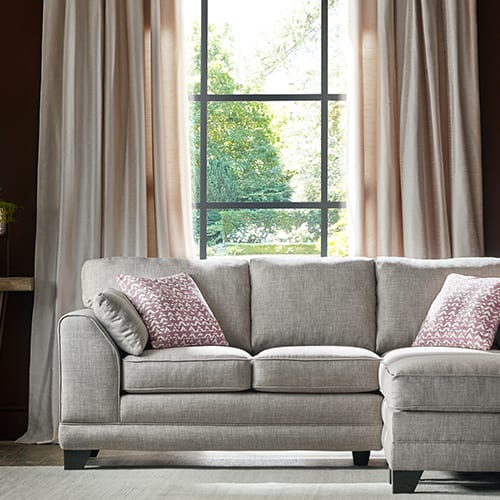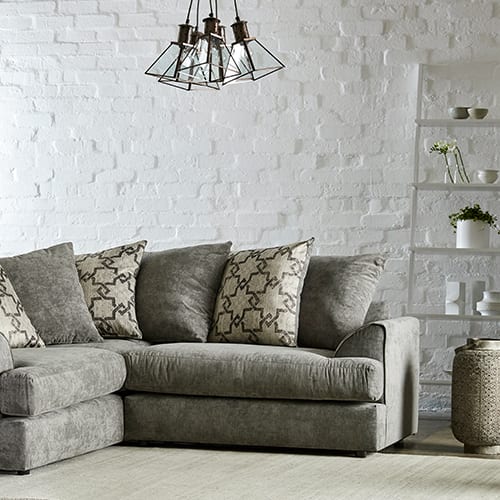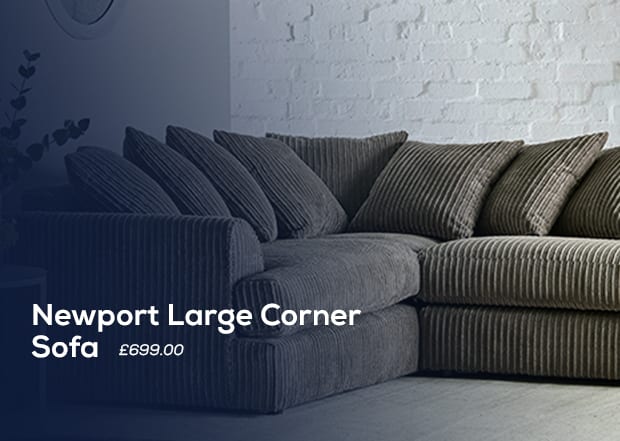How to Choose and Buy a Sofa — Step by Step Buyer’s Guide
Choosing the right sofa is a mission.
Will it fit in the space? Can I get it on my property? What material should I pick? Will it look good?
Such an essential part of the household makes for an important buying choice. You should choose a sofa that brings the room — and most importantly, the people you love — together.
We’re here to help you find out which sofa would be perfect for your home and lifestyle. In this guide, we’ll offer advice on different kinds of sofas and materials. We’ll let you know how to place the model you decide to purchase.
It’s a big decision, but we know that you’ll make the right choice with this guide.
Table of Contents
What are the Different Sofa Types?
Other than your choice of colour, there are two primary concerns when buying a sofa — the size and the material. This isn’t just important for interior design — it can be an issue when getting the sofa into your home.
We’ll now talk about the different sizes and styles available so that you can make the right choice for your space.
Sofa Types By Size
2 Seater
A two-seater sofa is ideal for couples or small families. It provides room to sit back and stretch out without occupying too much space in your living room. For this reason, it’s also an excellent choice (arguably a must) for homes where space is limited.
If you like to recline in luxury, you may prefer a two-seater with a single long seating cushion and fixed back. If you have young children, they often prefer their ‘own’ seat, so a model with two detachable cushions may be preferable.
3 Seater
Three-seater sofas are larger and perfect for families. These sofas usually come with three separate seating cushions but can also come with two longer cushions or even without divisions.
A three-seater is also well-designed for spreading out and watching TV or snuggling up with a loved one.
Corner
A corner sofa fits snugly into a living room that has space available on multiple walls. These models are perfect for an evening of sprawling relaxation in front of the TV.
It’s essential to assess the dimensions of your living room before purchasing a corner sofa, as you don’t want to obstruct cupboards or natural light.
Corner Chaise
The chaise is famous for its ‘L’ shape, which allows you to recline and stretch your legs out. The short part of the ‘L’ typically has a low back to fit neatly under windows.
A chaise can come in any size, but today many designs tend towards larger, more luxurious models.
Swivel Chairs
A swivel chair is a cosy seat that you can rotate as you please. This is perfect for moving back and forth between the TV and guests or for users who find craning their necks back and forth painful.
Swivel chairs often come with comfortable arms and are an indulgence to sink into after a long day.
Armchairs
Armchairs are incredibly diverse, ranging from plush, swallow-you-whole models to austere statement seats. The common denominator is that — yep, they all have arms.
Armchairs frequently have more upright backs than other seats. These chairs are often considered ideal for those with bad backs, as they provide ample support without sacrificing comfort.
Sofa Types by Material
Choosing the right material for your sofa is equally important. Whether it’s for comfort, ease of cleaning, or a wider choice of colours, we’re here to let you know which materials may be best suited to your home.
Fabric
Fabric sofas offer comfort and tend to be more durable and easier to clean than many alternatives. Fabric is an ideal upholstery choice for families with pets or young children.
Fabric is also incredibly versatile in terms of colour, so it often makes the perfect choice for bringing your living room together.
Faux Leather
This choice helps achieve the elegant, classic look of a leather sofa without commanding a heavy price. Intensely comfortable, easy to clean, and pleasing to the eye, a faux leather model can bring richness into your living room.
Cushions only require water for cleaning, saving you time on housework. Plus, if you spill a drink, the seat can be wiped and ready for use again in a jiffy.
Velvet
Even the word ‘velvet’ evokes the feeling of the fabric — soft, sumptuous luxury, deep colours, and a feeling that you’re probably not going to get up for the next few hours. Velvet sofas have a gorgeous classic look that sets them apart from the crowd.
Note that velvet requires more maintenance than some upholstery choices — but we know that if you’re a velvet fan, you’re going to show it the love it needs.
Crushed Velvet
Another luxurious option is crushed velvet, known for its almost iridescent sheen. Crushed velvet manages to be chic and invitingly snug simultaneously, making it a fantastic choice for young couples or buyers who love to entertain.
How to Measure a Sofa
Measuring a sofa before making your purchase is vital for two reasons:
- Fitting it into the room of your choice
- Fitting it through your door
The dimensions of a sofa are Height (H) x Width (W) x Depth (D).
- The height is from the sofa’s feet or base to the top of the back.
- The width is from the furthest point of each of the arms.
- The depth is from the back of the sofa to the front.
Seat Height
You should also measure the seat height. This will help you configure your room around the sofa, e.g. height of coffee tables, TV, footstools.
Arm Height
Measure the height of the arms. If the sofa is likely to be placed with one arm near a windowsill, it should be lower than the height of the windowsill.
Note that some corner sofas come in two parts, so you should measure them separately.
Getting the Sofa Into Your Property
Now it’s time for the hard part.
Through the Front Door
For the front door, start by measuring the width and height of the door.
Option 1
If the height of the sofa is less than the width of the front door, congratulations! The sofa can be moved when turned on its back.
Option 2
If not, check the width of the sofa against the height of the front door. If the door is taller than the sofa is wide, you may be able to move the sofa through on its end.
Hallways and Doors
Any door the sofa has to pass through should be measured widthwise at its narrowest point.
If it has to pass around corners, you should make sure that the corner is wide enough before making a purchase.
Measure the sofa from where the base and the back meet. Measure upwards at a 45-degree angle until the tape measure is equal to the sofa’s height. This measurement should not be greater than the width of the corner.
Sofas are usually easier to get around corners when on their end. Always make sure you have space to safely move the sofa without becoming trapped and observing safe lifting practices.
Stairways
- Measure the width of your stairway at its narrowest point. If the height of the sofa is less than this, it should pass up the stairs.
- If your stairs pass under a landing or around a corner, measure this space at its narrowest points. The measurements should be greater than the H x W x D of the sofa.
- If the sofa needs to pass over a bannister, ensure adequate space between the bannister and ceiling.
What Sofa Fillings are Most Common?
Choosing the correct filling depends on your aesthetic preferences as well as how you like to sit.
Foam Upholstery
- Durable, low-maintenance cushions
- Will support your back well
- Offers an attractive, tailored aesthetic
Foam with Fibre Wrap Fillings
- Soft, plump-looking cushions
- A plush, supportive feel when sitting down
- Longevity of cushions due to foam core
Fibre Filled
- Ultra-soft cushions for relaxation
- Maintain the aesthetic and feel of the sofa with regular plumping
- Allows you to sink in after a long day
Choose & Buy Your Sofa in 3 Steps
We’ve covered size. We’ve covered materials. We’ve covered cushions. We also know how to get the sofa into our home.
That means it’s the fun part — decision time! Which sofa will you choose?
1. Sofa Shape & Style
Are you looking for a classic sofa that makes a statement in your living room? Perhaps you’d prefer a more contemporary design or one made for comfy relaxation?
Consider whether the sofa fits into your living space comfortably and matches the room’s style.
Picture it in your living room; picture a loved one’s elbow resting on the arm of the sofa while you sit and chat. Does the scene feel natural?
2. Sofa Material
Perhaps a luxurious crushed velvet design would augment your stylish living room, bringing a statement and depth. Maybe you can see your kids and pets playing on the sofa — remember to pick a material that will stand the test of their affections.
If you feel at peace resting on the material you’ve chosen, you’re onto a winner.
3. Sofa Filling
Maybe you’re looking for cushions that will provide comfortable support while you spend a lazy afternoon watching TV. Low-maintenance materials like foam or foam with fibre wrap fillings are perfect for this purpose.
Maybe you’re looking for soft, elegant fillings that your guests will coo over. Plush fibre-filled cushions are a fantastic option in this case, and isn’t plumping up cushions so satisfying?
So, to recap:
- You’re sure that the sofa will fit into your home.
- You can picture yourself enjoying it for years to come.
If these two things are true, then good news — you’re ready to make a confident buying decision.
FAQs — Other Points to Consider
Q: What’s the best sofa for a small living room or space?
A: A two-seater is usually the best bet for smaller living rooms. If wall space is available, a corner sofa can bring a lot of seating space without making the room feel cramped.
Q: What style should I choose?
Look at the room you’re planning to put the sofa in. How is it decorated? What other additions might you make? The style is entirely up to you, but matching your sofa with your room’s ‘theme’ is always a good bet.
Q: How long should my sofa last?
Sofas upholstered with durable materials and low-maintenance fillings will last for many years in good condition. More delicate materials such as velvet can also last a long time but require regular care, or they may lose their lustre.
Q: What’s the best material for a sofa?
This depends on your lifestyle. If you have children or pets, the fabric upholstery is generally preferable to faux leather or velvet as it doesn’t scratch and is easier to clean than velvet. However, these materials can be extremely attractive and are popular choices with less chance of wear and tear.
Q: Will my sofa fit?
See our handy step-by-step guide above to learn about fitting a sofa into your home.










